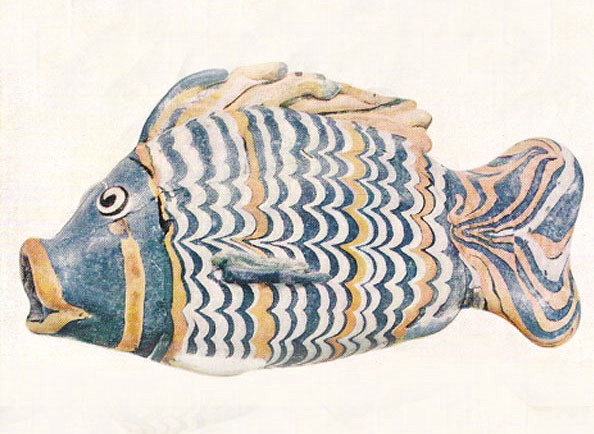American Sea Writing and the Poetry of the Ocean

“Polychrome Vase in the Form of a Fish”
British Museum Postcard
El-Amarma, XVIIIth Dynasty, (c. 1365 BC)
Glass. 1.2 3/4″
The British Museum, London
Writing for World Ocean Observatory involves describing policies and projects in specific detail — journalistically correct but not always as evocative as can be. Sometimes the more emotional and abstract observations do better at making the point by realizing the acuity of an experience. I have been teaching a seminar with readings drawn from an collection entitled American Sea Writing: A Literary Anthology that I edited in 2000 for the Library of America, New York, as an alternative to similar compendia of mostly British authors and experience.
The course has been focused on identifying and hearing unique American voices and narratives related to ocean passage and coastal observation. The approaches and themes are many. Among them the ocean as metaphor; as a place apart and psychological space; the storm as epic event; exploration and the naming of places and things; voluntary and involuntary immigration; sea power in relation to imperial expansion and the opening of trade; the coast and life on the edge; women at sea; diversity and integration of crews; the mariner’s log as personal journal; the voyage as a story of coming of age; acculturation through maritime exchange of goods and ideas; the building of an American ideal; survival and death and the transforming nature of life; the pilot and the hand of God. The literature of the maritime experience is a very rich story indeed, a wonderful cacophony of distinct voices and a perspective on the history of the United States that is not often identified and shared.
Here is a poem from that collection, The Fish, by Marianne Moore (1887–1972), first published in 1918, that, as described in my introductory note to American Sea Writing, “renders the profusion of undersea life with her characteristic detachment and attentiveness. However precise, the poem is also alert to the less tangible presence of the ocean, its unseen essence of force and motion. Out of the immediacy of the aquatic world emerges a vision of the sea in all its battered, timeless grandeur.”
THE FISH
by Marianne Moore (1887–1972)
wade
through black jade
Of the crow-blue mussel-shells, one keeps
adjusting the ash heaps;
opening and shutting itself like
an
injured fan.
The barnacles which encrust the side
of the wave, cannot hide
there for the submerged shafts of the
sun,
split like spun
glass, move themselves with spotlight swiftness
into the crevices–
in and out, illuminating
the
turquoise sea
of bodies. The water drives a wedge
of iron through the iron edge
of the cliff; whereupon the stars,
pink
rice-grains, ink-
bespattered jelly-fish, crabs like green
lilies, and submarine
toadstools, slide each on the other.
All
external
marks of abuse are present on this
defiant edifice–
all the physical features of
ac-
cident–lack
of cornice, dynamite grooves, burns, and
hatchet strokes, these things stand
out on it; the chasm-side is
dead.
Repeated
evidence has proved that it can live
on what can not revive
its youth. The sea grows old in it.
- - -
- Login to post comments
-


